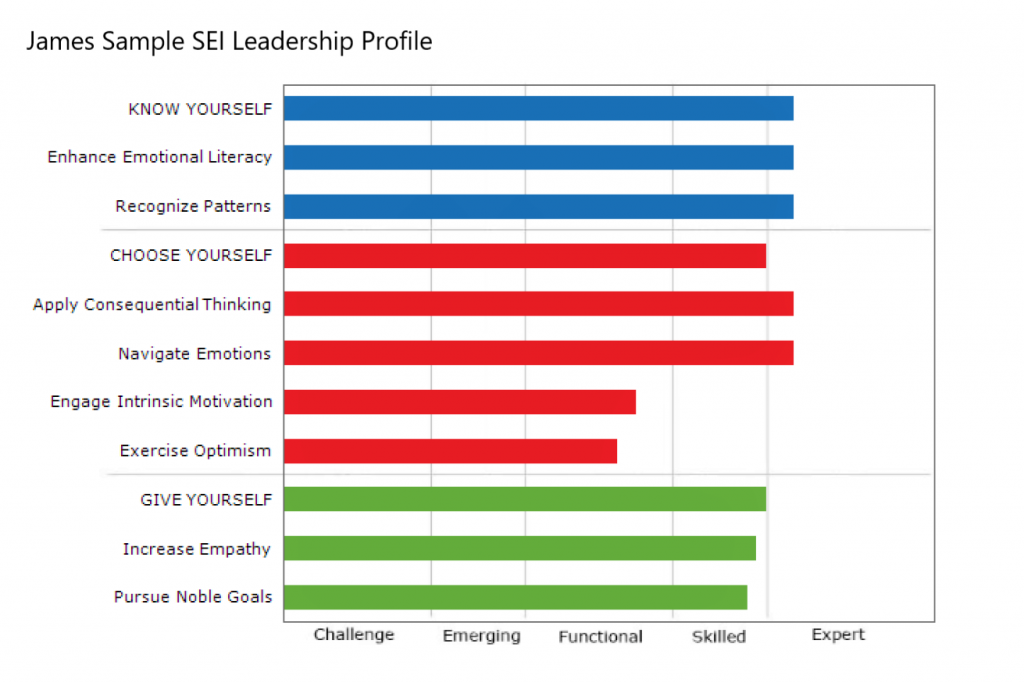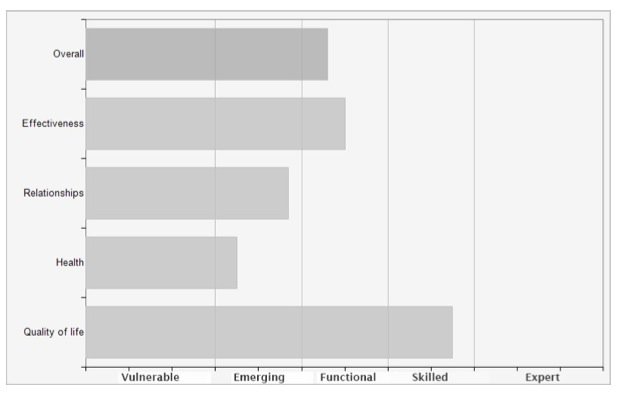SEI Profile

SEI offers a practical, powerful framework to understand and grow emotional intelligence.
Why? There is a growing body of research evidence that the learnable, measurable skills of emotional intelligence are the “Difference that makes the difference”
FedEx: 59.8% of leadership performance predicted by EQ.
New managers increased EQ by 12% yielding dramatic improvements in effectiveness.
Amadori: 76% of employee engagement predicted by EQ.
Higher EQ managers have a more committed workforce and drop turnover by 63%.
Komatsu: 9.4% increase in plant productivity.
In three months of integrating EQ to increase vitality, engagement doubled.
The World Economic Forum’s “The Future of Jobs” research identifies emotional intelligence as one of the top skills for the future. Why? Today, success requires collaboration, influencing across boundaries, and navigating complexity — skills that are fueled by emotional intelligence (or “EQ”). But it’s not enough to “have” the skills — results come from using them.
That’s why SEI offers a robust framework for putting EQ into action, including the world’s irst machine-learning neural network for translating EQ data to practical action steps.
Leadership Report brings together EQ skills for management roles.
Why is EQ important for a leader?
Leader’s objective is to motivate employees and teams to do work beyond their capacity. It is about enrolling people to utilize their full potential. When a leader is aware, authentic, passionate, and acts in integrity, s/he will build trust, commitment and alignment to foster an environment where people can bring their best to the table.
There is no formula for effective leadership, no magical path to follow. A great leader makes her or his own path – one that is uniquely based on his or her own skills and attributes. A leader cannot imitate someone else’s style or use a prescribed set of behaviors. Instead, he/she assess carefully him/herself to know his strengths and vulnerabilities and move forward. This report will give the insight to build and apply his EQ to improve leadership.
Sample Interpretation
This example is of the full profile in the Leadership Report (fined profile image above). “Hank Lennox” is an operational manager in a high tech company. In the blue section, we can see Hank is modestly self-aware. If he slows down, he can notice his feelings and choices. But in the red area, it appears Hank is so busy “doing” he doesn’t deal with the underlying emotional drivers.
Remarkably self-motivated and optimistic, Hank has incredible strengths as an operator — but he is very weak in managing emotion (Navigate Emotions — he’s careful (Apply Consequential Thinking), but he doesn’t create the right emotional drivers to sustain his performance.
In the green area, it’s evident that he is driven by a powerful, meaningful purpose (Pursue Noble Goals), but he’s got an achilles heel in Empathy, and can not enroll people.
In the hands of skills practitioner, this data is incredibly powerful. We can make numerous inferences and begin to talk to “Hank” about some massive strengths — and what’s holding him back. Looking at the Navigate Emotions and Pursue Noble Goal scores, it’s evident that he’s emotionally disconnected from his own sense of purpose.
He’s operating at a “head level.” The massive engines of Engage Intrinsic Motivation + Exercise Optimism might actually be running too fast, causing him to run people ragged — is it enough for him to be a sole star, or does he want a winning team?
Based on the high PNG, we can leverage his vision to make a commitment to bringing others along. But for Hank, as for so many leaders, his first step is to increase the selfawareness. Until he tunes into what’s happening internally, he’ll keep tripping over these low scores. fortunately, he has the capability in Apply Consequential Thinking to see these risks… and the drive in EIM and PNG to do the work.
Of course, the feedback from an assessment is just that: Feedback. We use the data to guide the conversation, and we support the client to reach her goals.
One of the key benefits of the SEI (which must be pretty interesting to you if you’re still reading – thank you) is that we actually have two questionnaires in one. We have the EQ scales, above, and we have a second questionnaire about key success factors.
The results of this questionnaire fall into six categories, four of which appear in the current Leadership Report (all six appear on the Coach Data page as background for the Assessor). This enables us to have the “so what” — the reason the client will want to explore and develop EQ.
In “Hank’s” case, his self-reported success factors, shown below, represent some serious concerns that he has, particularly about health and relationships, and a lot of room for improvement in other areas. The Assessor will use this data to help Hank frame up the need for change, and to understand his goals. Then, as we look at the EQ competencies above, it’s easy to start focusing the conversation on these key outcomes:

You can obtain SEI Leadership by filling the form below or reach us via ask@pausefactory.org
